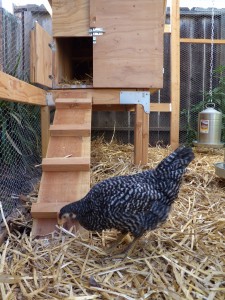
Our ridiculous beekeeping outfits.
At this time yesterday, I could have told you honestly that I had never been stung by a honey bee. Yep, despite working in gardens for years and keeping 14 different hives over the past year, I was sting free.
Kelly and I certainly don’t underdress when we go out to work the hives. Our getup includes full bee suits replete with Velcro, zippers, and nylon mesh, as well as gloves with elastic cuffs that reach past our elbows. We have been told more than a few times that we look like fencers or astronauts.
But aside from our protective bee gear, the honeys are also generally quite mellow, and we move slowly with them. The aggressive insects many people call “bees” are really yellow jackets, hornets, and wasps. Humans offer little of interest to the vegetarian honey bee, and bees are focused on their jobs in the world, not (usually) intent on hunting you down. When a honey bee stings, she dies.
Last night, Kelly and I headed out to a site where we have been collecting swarms this spring. It’s a popular spot with the bees, and about 10 colonies have chosen it so far this spring, only to be whisked away by beekeepers like ourselves. Bees can’t see well at night, and they generally retire to the inside of the hive. Thus, evening is a perfect time to block off the entrance to the hive and move it to a permanent location.
Unfortunately, the bees had other plans last night. We arrived at dusk and climbed the 10-foot ladder to the generator rooftop where the bee lures are located. We were disappointed to find a large number of bees milling around outside the hive entrance.
Without suiting up, we sat and watched them from a distance for a while, and it was then, minding my very own business a good five feet away, that a bee approached me. She seemed a bit testy from the start, landing on my arm and running around. I sat quietly and did my best psychic bee communication attempt to let her know that I meant no harm and would love to be left alone. To no avail. Apparently her job was to protect the colony.
She moved to my neck, then up into my hair, and the tone of her buzzing changed as she grew more agitated. I have to admit it: I freaked out at that point and attempted to swat her away. This is a big no-no, but I felt I had nothing to lose. I swatted violently a few more times, managing to bruise my finger on the metal roof before she sunk her stinger.
I hate pain and have no tolerance for it, but I still have to say that bee stings really hurt. It’s a fiery, focused, deep pain. It reached into my skull and landed me with a dull headache around the forehead.
But what really hurt (and I laugh at myself as I write this) was how wounded I felt. Keeping bees entails disrupting them, manipulating them for human gain, inevitably squishing a few along the way, and making choices about where they will live and how. Still, on some level I view myself as a friend to each hive, a benefactor entitled to enter at will. To be stung as I watched the hive from a distance, even after all my clumsy fumbles and missteps over the past year, felt like a betrayal.
The bees never went in last night. We finally left them around 11:30 after a bee crawled up the leg of Kelly’s suit and stung her. We’re headed back for another go-around tonight and are adding a spray bottle of water, wood, and a roll of duct tape to our arsenal. Keeping bees is hard work, but being a bee might be harder.










